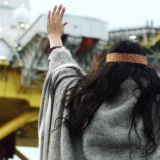Dawn in Tel Megiddo: A Snapshot of Daily Life on an Ancient Dig
May 17, 2013
Author: Julye Bidmead, Ph.D.
Wilkinson Review 2013
The full moon is setting over the Jezreel Valley as I begin my 5:00 a.m. daily climb up the steep and rocky terrain to Tel Megiddo. After two months my legs still ache and I fight off the fatigue from a night with too little sleep, but the adrenaline of the upcoming day makes the climb almost effortless. Over 125 team members ranging from age 16 to 65 make the climb with me; some quiet in pensive thought; others with headphones listening to music from their iPhones. During the clear I overhear snippets of conversations in English, Hebrew, French, Spanish, and other languages I don’t recognize. My own thoughts are actively organizing the daily tasks ahead. As we reach the summit the team divides up into four dig areas where excavation in the scorching Israeli sun will continue until 1:00 p.m. Our dig areas are shaded, but it’s still hot, and there is much work to be accomplished in the next eight hours. The cool pre-dawn hours offer the most pleasant working conditions. The team wastes no time as they gather their tools and hurry to their assigned tasks. Our area team, of approximately 25 students, is divided into eight squares (smaller areas of excavation measuring 4 X 4 meters) with about two to three students to a square. On a daily basis each student will likely collect an entire bucket of broken pottery shreds, bags full of animal bones, flint tools, seeds, and other artifacts. Almost immediately after work begins a student calls out that they have found something unusual they need me to see. I climb down the ladder into the square to see what she has uncovered. She hands me a piece of dark brown, almost reddish burnt clay-like material. Instructing her to scrape the ground with her trowel, a circular shaped outline of this material starts to appear. She has discovered the top of an ancient tabun, a cone-shaped clay oven used for baking bread. Tabuns during this period were cut into the ground, and I soon realized that the student was close to finding the floor of this ancient kitchen. Before finishing with her, another student requests my attention. Climbing back up, and then into the next student’s square, I notice that he has found a small bronze pin likely used to hold clothing together. The pin is recorded as an artifact; measurements and pictures are taken, and work resumes. Not long after that I check on another student as he uncovers a wall while a few feet away a young woman is unearthing a complete juglet. As the jug is very near the courtyard where a jewelry horde was previously discovered; caution is warranted. Earlier in the summer of 2011, a year after it was excavated, the ceramic vessel awaiting molecular analysis of its soil was opened. Hidden within it were over 1000 gold, silver, and carnelian beads with several gold moon-shaped earrings. The student proceeds to carefully excavate the vessel hoping that today’s find may also yield such treasures.
Continue reading this story in the Spring 2013 addition of the Wilkinson Review page 6

